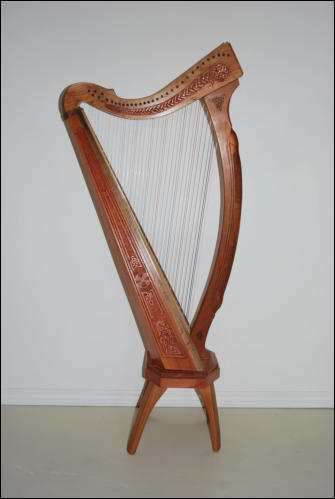

OK to begin with this story goes back two years ago when I was visiting my sister and her husband Dave in Huston, B.C. While we
where there it came out in a conversation with her that even as a little girl it was always her heart’s desire to own a harp. Needless to say
it’s been a long time since either of us have been children but I decided then and there that I would make her such a gift. I searched the
Library and the Internet for harps; most I didn’t like, being either too cheap looking or simply too expensive. There was nothing there
that said “my sisters”. So again after doing more research I came across an article in a woodworking magazine about harp making by a
man named Hillard Stone. I took one look at the harps he had made and decided that this was the one I had to have for my sister. So I
contacted Mr. Stone to inquire about his harps, he replied that he was retired now and was no longer making them. I then asked Mr.
Stone if he had any plans that where still available and he said that he had a few left and that he would send them to me if I gave him my
address. Much to my surprise and delight a week later I received his original plans for the harp. Thank you Mr. Stone for your most
gracious and generous offer.
It is said; that once a Harp is created, it is on the road to destruction. This is because of the enormous stress on the wood from the
strings tension. On a mid-sized harp such as the one I’ve made there is over a thousand pounds of pressure on the harp. Larger classical
harps must support over a ton of tension on the body so a lot of careful preparation is in order.
The harp I made is composed of Black Cherry wood for the main body as well as the legs, arm and post. The sound board is made
of Sitka Spruce with a bridge made of Hornbean wood. The sides of the sound board are trimmed with mahogany.
The original plans called for a round backed harp but I thought that a “coved-backed” harp would be more in line with my
abilities, little did I know how wrong I was in my choice. The pieces of a coved back are tapered and angled in three dimensions. So any
error in one direction is greatly magnified in all of the others. It was at that point that my mother’s words came back to haunt me about
the KISS concept: “Keep It Simple Stupid.” After much thought, cold sweat and the creation of a few ingenious jigs on my part I might
add. I managed to make everything work out. Did I mention that I have never been a woodworker or Luthier “that’s someone who
makes musical instruments”, by the way! So after everything is made it came time to glue the pieces and put them together. And to my
surprise and pleasure, it worked. After that I installed the tunning pegs and bridge pins in final preparation for the harp strings. Again, I
must stress, I have no musical background. I learned to tie a “harpers knot” and successfully strung the instrument. After weeks of
tightening the strings and letting all the parts settle into place I was able to tune the harp to an acceptable level. Harps can take months
to settle into place and need tuning on a daily bases until the sound board bows and all the stresses equalize in the wood. After that
usually only minor regular tuning is required.
After a final lacquer coating and polish it was time to give it to my sister. So my wife and I loaded up the harp and our luggage to make the twelve hour drive to my sisters
place. Needless to say she was overwhelmed by the gift and I won’t go into details that are best kept private, but I consider it a small effort on my part to give a token of affection to
my sister, after all family is the most important thing in a persons life. And better to say and show people how you feel about them now rather then later as there may not be another
time. So perhaps that’s the real song of the harp.
Leslie Dycke

To Listen to the Harp
Click the File Below














